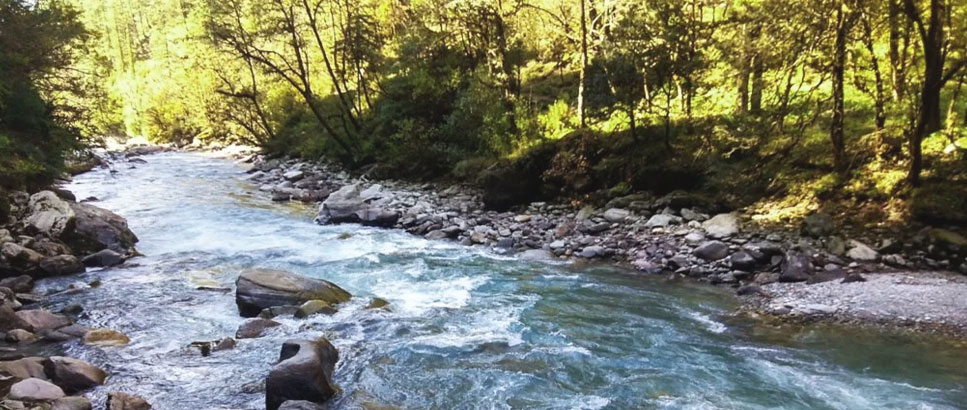
Moving on the Char Dham Yatra an extraordinary pilgrimage in the Indian Himalayas is a profound spiritual journey that draws millions of devotees each year. The Char Dham refers to four sacred sites: Yamunotri, Gangotri, Kedarnath and Badrinath each associated with deep religious significance and breath-taking natural beauty. This sacred circuit offers a lifetime of memories and a spiritual awakening that remains etched in the heart forever.
Yamunotri: The Source of the Yamuna
The journey begins at Yamunotri, the source of the Yamuna River and the seat of the goddess Yamuna. Snuggled in the Garhwal Himalayas at an altitude of 3,293 meters, Yamunotri is surrounded by lofty peaks and dense forests. Pilgrims start their trek from Hanuman Chatti covering approximately 6 kilometres on foot or horseback. The trek itself is a blend of challenging paths and picturesque landscapes with the River Yamuna flowing alongside.
At Yamunotri the main attraction is the Yamunotri Temple a revered site where devotees offer prayers to the goddess. The nearby hot springs Surya Kund and Gauri Kund are also significant. Pilgrims cook rice and potatoes in the hot water of Surya Kund believing that consuming these offerings brings blessings. The serene ambiance and the sight of the snow-clad mountains make Yamunotri a spiritually uplifting experience.
Gangotri: The Abode of Goddess Ganga
From Yamunotri the next stop is Gangotri the origin of the sacred River Ganges. Situated at an altitude of 3,100 meters, Gangotri is a small town enveloped in the serene beauty of the Himalayas. The Gangotri Temple dedicated to Goddess Ganga is the main highlight. It is believed that King Bhagirath performed penance here to bring the river down from the heavens to cleanse the sins of his ancestors.
The journey to Gangotri is an enchanting one, with the river flowing majestically alongside. Pilgrims often visit the Gaumukh Glacier the actual source of the Ganges located 19 kilometres from Gangotri. The trek to Gaumukh is arduous but rewarding offering stunning views of the glacier and surrounding peaks. The spiritual aura of Gangotri and the sight of the holy river flowing through the rugged terrain leave an indelible mark on every visitor.
Gangotri: The Abode of Goddess Ganga
Kedarnath the next destination, is one of the most revered shrines dedicated to Lord Shiva. Perched at an altitude of 3,583 meters this temple is the highest among the 12 Jyotirlingas in India. The trek to Kedarnath begins from Gaurikund, covering a distance of 16 kilometres. The path is steep and challenging but the spiritual fervor of the pilgrims and the stunning views of the Kedarnath range make it a worthwhile endeavour.
The Kedarnath Temple believed to be built by the Pandavas and later renovated by Adi Shankaracharya is an architectural marvel. The temple’s backdrop of snow-covered peaks adds to its divine charm. Pilgrims believe that offering prayers here absolves them of their sins and grants them moksha (liberation). The serenity and spiritual energy of Kedarnath create a sense of tranquillity and fulfilment.
Badrinath: The Home of Lord Vishnu
The final stop of the Char Dham Yatra is Badrinath the abode of Lord Vishnu. Located at an elevation of 3,133 meters, Badrinath is situated between the Nar and Narayan mountain ranges with the mighty Neelkanth peak providing a stunning backdrop. The Badrinath Temple established by Adi Shankaracharya is a significant pilgrimage site for Vaishnavites.
The journey to Badrinath is picturesque, passing through dense forests, rivers and majestic mountains. The temple’s idol of Lord Vishnu made of black stone is believed to be self-manifested. Pilgrims take a holy dip in the Tapt Kund a hot spring near the temple before offering prayers. The town of Badrinath with its spiritual ambiance and natural beauty, leaves pilgrims with a sense of peace and contentment.
The Char Dham Yatra tour is not just a journey through the majestic Himalayas; it is a voyage of self-discovery and spiritual awakening. Each of the four dhams offers a unique experience blending religious significance with natural splendor. This pilgrimage instils a sense of devotion, humility and inner peace making it an everlasting experience etched in the hearts of those who undertake it.